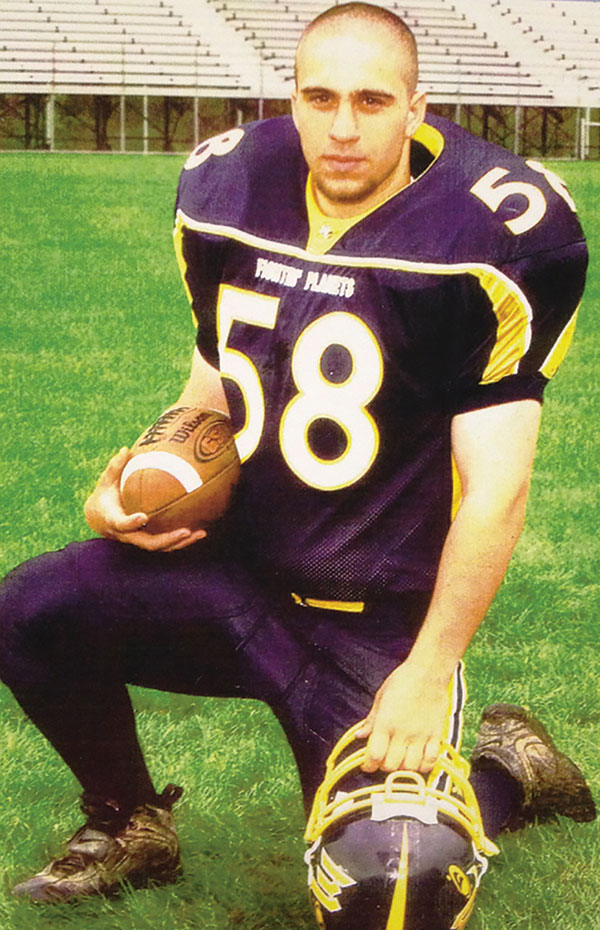
Teen Nick Varrenti died suddenly of SCA.
When Matthew Truax performed in his Meadowdale High School’s sophomore dance show, he and a dozen teens moved in near unison in front of hundreds of cheering classmates. During Journey’s ballad “Don’t Stop Believin’,” the Edmonds teen had no problem hoisting a female classmate onto his shoulders.
Why would he? He was a healthy kid who had played sports since age 5, played on a recreational soccer team, snowboarded, had no known health problems and had passed his sports participation physical exams.
But last September, during a routine one-mile pacer run during PE class, a classmate noticed Matthew suddenly slow down. He complained of leg cramps, then passed out on the track.
At around 9:30 a.m., Matthew’s parents, Jerry and Melinda Truax, got a phone call from school officials, who told them that Matthew had collapsed. Later that morning, their youngest son was pronounced dead at the hospital of sudden cardiac arrest, caused by a heart condition they hadn’t known Matthew had. He was five days shy of his 17th birthday.
There was no Truax family history of cardiac issues. “As far as we knew, everything was fine. We just had no idea,” Jerry Truax says.
Silent killer
Every three days in this country, a young athlete dies of sudden cardiac arrest (SCA), according to Dr. Jonathan Drezner of UW Medicine’s Department of Family Medicine, a sports medicine expert and team doctor for the University of Washington Huskies and the Seattle Seahawks.
There are usually no warning signs or symptoms of SCA. Put simply, it is when the heart stops beating. It is the leading cause of death in the U.S., with less than an 8 percent survival rate. For reasons not yet fully understood by researchers, SCA affects teen athletes disproportionately among that age group.
“There’s a perception that athletes are the healthiest members of society,” Drezner says. “Parents think, ‘My kid got a physical, so he is OK.’ In these pre-participation physicals, we walk through an exercise that builds out paperwork and shares liability risk, but doesn’t do a good job looking under the hood.”
A Seattle-area foundation is trying to change the odds for kids like Matthew Truax by looking under the hood of more teens more closely. The Nick of Time Foundation provides thorough cardiac screenings, which include electrocardiograms (EKGs) to check the heart’s electrical rhythm, and, if anything abnormal is detected, an echocardiogram to assess the heart’s size, shape and any possible structural defects.
Screening solution
The Nick of Time Foundation, borne out of another family’s tragedy, offers these on-site screenings at eight local high schools each year. Since 2010, more than 9,000 students have been screened. More than 300 teens were found to have abnormalities that warranted further medical attention.
The first time we found a girl with a hole in her heart, it was bittersweet,” says Darla Varrenti, the foundation’s founder. “It was sad, but we knew she could be fixed and it wasn’t too late.”
Spending a whole day at each school, the volunteer medical experts and more than 100 helpers on site can check as many as 500 students. A schedule of host schools is on nickoftimefoundation.org, and the suggested $25 donation is a pay-it-forward model that helps fund the next school’s screening. High schools are now so interested in bringing the program to their students that the waiting list is three years long.
Darla Varrenti founded the Nick of Time Foundation out of personal grief. In the fall of 2004, her youngest son, 16-year-old Nick, was played in a Jackson High School football game on a Friday night and a junior varsity game on Saturday. All seemed perfectly fine, and Nick went to bed on Sunday night with no complaints or symptoms. But when his dad went to wake him for school on Monday, the teen was dead; he had suffered cardiac arrest in his sleep.
Remembering how much her son loved athletics, Darla Varrenti emphasizes, “We’re not trying to keep kids from playing sports. We’re trying to make sure it’s safe for them to play the sport they love.”
By the numbers
Sudden cardiac arrest causes six times the number of deaths in sports than head trauma, according to Drezner, who volunteers for Nick of Time. And while all young people are at risk, he says, studies now clearly show some groups are at higher risk, particularly boys, black athletes and, for reasons researchers cannot yet explain, basketball players.
“One in 7,000 college basketball players dies from SCA, and truthfully, we don’t know why,” says Drezner. News of Loyola Marymount University basketball player Hank Gathers’ death in 1990 put the national spotlight on SCA, at least for a time, but there are still many unknowns, and many cases end up as silent killers.
In both Matthew Truax’s and Nick Varrenti’s tragedies, the underlying cause of their cardiac arrest was a condition called hypertrophic cardiomyopathy (HCM), a disorder that causes abnormal thickening of the heart muscle. Other causes of SCA include congenital abnormalities of the coronary arteries or electrical disorders. Both Varrenti’s and Truax’s parents believe that if their sons had been screened, the boys would likely be alive today.
Bystanders can save lives
In addition to cardiac screenings, the Nick of Time Foundation works to educate all teens and their families about CPR and bystander use of automated external defibrillators, commonly known as AEDs. The group is working hard to get schools and sports teams to have AEDs easily accessible in buildings as well as on the sports fields during all practices and games.
“Many adults don’t recognize cardiac arrest when a kid collapses,” Darla Varrenti says. “They stand by and watch, when what they should be doing is starting CPR, having someone call 911 and finding an AED.”
Kasandra Dungate, who was a junior at Stanwood High School when she suffered cardiac arrest while getting out of bed for school, can thank her grandmother’s training in CPR for helping save her life. Even with that, plus an emergency medical response within minutes of the 911 call, it still took eight shocks to resuscitate the teen.
“It was horrible,” Jeanne Dungate says, recalling her granddaughter’s body being lifted up and down off the hardwood floor.
Unaware of it at the time, Kasandra had a condition called long QT syndrome, an electrical disorder of the heart. Her condition would likely have been detected beforehand if she had had an EKG. In fact, after Kasandra’s near-death experience, the family now believes they have the answer to why Kasandra’s mother died in her sleep at the age of 26.
After 11 days in Seattle Children’s Hospital’s intensive care unit, and many months of rehabilitation, Kasandra, now 20, and her loved ones feel lucky she is alive. “She went through a lot of miracles,” her grandmother says.
Kasandra now volunteers at Nick of Time screenings. And through the organization’s Anyone Can Save A Life program, teens are learning how to handle an SCA situation immediately with CPR and AEDs. The devices, which are roughly the size of a lunch box, cost approximately $1,200, and Drezner says they should be as common in schools as fire extinguishers.
Suzanne Apodaca, Darla Varrenti’s sister and the foundation’s director of operations, says young people are often the best influence on their peers. “Adults think about things like liability, or they think, ‘Oh, the kid is probably doing drugs.’ It’s the young people who, if you give them the tools, are going to change the world.”
And if the SCA, AED and HCM talk feels like an alphabet soup that’s too much to digest, Jerry Truax can only urge parents to think again. “Everything we’ve learned, we learned since Matthew died. We were virtually ignorant to all of this [until it was too late for their son],” he says. “We’ll spend the rest of our lives doing this.”
Hilary Benson is ParentMap’s television editor and a longtime news reporter. Her family includes three active kids who help fuel her passion for keeping children safe while they compete in the sports they love. She blogs at playitsafesports.com.
RESOURCES
- Nick of Time’s upcoming screenings.
- UW Medicine Sports Medicine Center: information and to make an appointment for a cardiac screening that includes an EKG (cost is $50).
- UW Medicine’s “How to Jump Start a Heart” slideshow.











